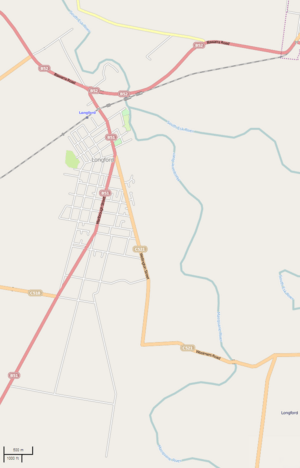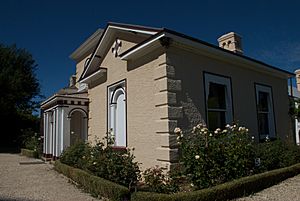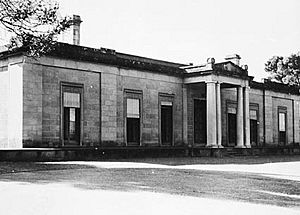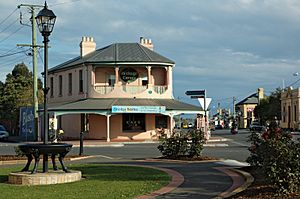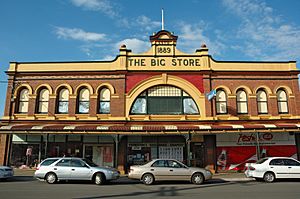Longford, Tasmania facts for kids
Quick facts for kids LongfordTasmania |
|
|---|---|
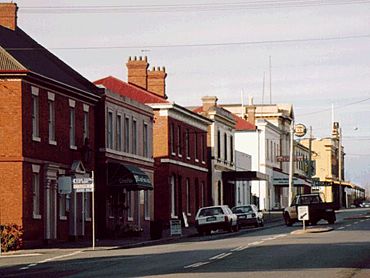
Wellington Street, Longford looking south
|
|
| Population | 3,863 (2016 census) |
| Established | 1813 |
| Postcode(s) | 7301 |
| Location |
|
| LGA(s) | Northern Midlands Council |
| State electorate(s) | Lyons |
| Federal Division(s) | Lyons |
Longford is a charming town located in the northern part of Tasmania, Australia. It sits about 145 meters above sea level where two rivers meet: the Macquarie River and the South Esk River. Longford is just 21 kilometers south of Launceston, a larger city, and it's only a short 15-minute drive from the airport.
This town is home to about 3,863 people, based on the 2016 census. It's part of the Northern Midlands Council area. The land around Longford is mostly used for farming. Farmers here are well-known for producing wool, dairy products, and raising livestock like sheep and cattle.
Contents
Longford's Past: A Journey Through Time
First People: The Panninher Clan
Long before Europeans arrived, the Longford area was the traditional home of the Panninher clan. They were part of the North Midlands Nation, an Aboriginal group. Colonists later called them the Penny Royal Creek Tribe. This name came from an old European name for the Liffey River, which the Aboriginal people called Tellerpangger.
The Panninher people lived and hunted across a large area. This stretched from Drys Bluff to the Tamar River, and south towards the Conara region. The Norfolk Plains area, where Longford is now, was an important hunting ground for them. It was also part of an ancient Aboriginal pathway.
European Settlement and Growth
The first Europeans to explore the Longford area were Jacob Mountgarrett and Ensign Hugh Piper in 1806. The next year, Lieutenant Thomas Laycock camped near where the town is today. This happened during his journey from Launceston to Hobart.
Settlers began arriving in 1807. Many were farmers who had moved from Norfolk Island to Van Diemen's Land, which is what Tasmania was called back then. Governor Macquarie gave land to these new settlers. They first named the area Norfolk Plains.
The town started to grow around a hotel built in 1827 by Newman Williatt. This hotel later became known as the Longford Hotel. In 1833, the town was officially renamed Longford. This name was likely suggested by the land commissioner, Roderic O'Connor. Early settlers used the labor of convicts to build many impressive homes and large farms.
The Archer Family's Legacy
The Archer family was very important among the early settlers. They built many grand houses and large estates in the area. Thomas Archer came to Australia from England in 1811. He left government work in 1821 to develop his 2,000-acre farm. By 1825, he owned 6,000 acres in the region. His success encouraged his brothers, Joseph, William, and Edward, and their father to join him.
Together, the Archer family farmed and developed the land. They built several homesteads that are still considered some of the finest in northern Tasmania. These include Woolmers Estate and Brickendon Estate, both of which are now on the Australian National Heritage List. Other Archer properties were Panshanger, Northbury, Fairfield, Cheshunt, Woodside, Palmerston, and Saundridge. Six generations of the Archer family lived at Woolmers from 1817 to 1994. Today, Woolmers is owned by a foundation and is open for visitors to explore.
The Norfolk Plains Post Office opened in 1832 and was renamed Longford in 1856. Near a modern recreation ground, you can still see the remains of the Longford Mill Dam. John Badcock built this dam in the 1840s to power a flour mill nearby.
Historic Buildings to Explore
The Longford area has many buildings listed on the Tasmanian Heritage Register. A lot of these important historic buildings were constructed between 1830 and 1850. Here are a few examples:
- Christ Church (1839): This church is made of sandstone. It has a square tower, pointed windows, and strong supports called buttresses. Its style is known as Old Colonial Gothick Picturesque. The church clock and bell were gifts from King George IV. The cemetery here is where many important local families, like the Archer, Brumby, and Reiby families, are buried.
- Queen's Arms Hotel (1835): This is a two-story brick building with a stucco finish. It's built in the Old Colonial Georgian style.
- Blenheim Hotel (1846): Another two-story Georgian building made of brick and stucco. It's a key part of Longford's town look.
- Tattersalls Hotel (around 1846): This building is now the Longford Library. It's a two-story red brick building on a corner, with fancy classic-style decorations around its doorways.
- The Racecourse Hotel (1838): This building used to be a coaching inn, a place where horse-drawn coaches would stop. It was originally meant to be the railway station for Longford and has also been a private hospital. Today, it's a bed and breakfast.
- Longford Railway Bridge: This bridge is 120 meters long and crosses the South Esk River. It opened in 1871.
Life in Longford: Facilities and Services
Longford offers many services for its residents. You can find a Service Tasmania shop, supermarkets, a bakery, and a butcher's shop. There are also two banks, a post office, antique shops, hotels, cafés, and hairdressers.
For education, Longford has a kindergarten and a large primary school. Older students travel to the District High School in Cressy or to schools in Launceston. The town has a sports center and a bowls club. Local bus companies provide transport for students and trips to Launceston. The Longford public library is part of the statewide library network and is open every weekday.
Healthcare is available from local doctors and dentists. Toosey Memorial Hospital used to be a private hospital. It became a public hospital in 1950. However, since 1990, it has been a care center for elderly people. The closest hospital for other needs is now in Launceston.
Working in Longford: Local Industries
In 2006, the most common jobs for Longford residents were in farming, school education, and meat processing. Many people also worked in residential care services and road freight transport.
Key Local Businesses
- Swift Australia (Southern) Pty Limited runs the Longford abattoir. This is one of the biggest employers in the region. The plant processes a large number of cattle and smaller animals each day and employs 460 people. Tasmania is the only Australian state that does not allow the use of growth hormones in cattle. This means the plant can guarantee its products are free of these hormones.
- Selborne Biological Services has a biotechnology factory in Longford. They make bovine serum and other blood products. These products are used in the biotech, pharmaceutical, and veterinary industries. They benefit from Tasmania being free of certain animal diseases like BSE and scrapie.
- International Therapeutic Proteins also has farms and a factory in Longford. They produce antitoxins and other biological products for similar reasons.
- Koppers Inc operates a wood treatment plant in Longford. They produce treated wood poles, timbers for piling, and other wood for outdoor use.
Other local businesses include Longford Brickworks, an agricultural machinery company called Agline, and Longford Sawmill. Many people also travel to Launceston for work.
Fun in Longford: Recreation and Activities
Longford Racecourse
The Longford Racecourse is the oldest racecourse in Australia that has been used continuously. Longford is also home to many places where horses are bred and trained. The Longford races are held every year on New Year's Day. This event features thoroughbred horse racing and the Elders Webster Longford Cup.
Longford Show
The annual Longford Show first took place in 1858. It is one of Australia's longest-running rural shows. Held in October, it attracts between 7,000 and 8,000 visitors. The show includes horse events, poultry and dog shows, wood chopping, and tree felling. There are also sheep and wool displays, rides, games, and artwork from local schools.
Longford Motor Racing Circuit
From 1953 to 1968, Longford was famous for its motor racing. Two Australian Grand Prix races were held here, along with several Tasman Cup races. Car and motorcycle championships also took place on the 4.5-mile (7.2 km) Longford Circuit.
Longford Golf Club
Longford has a popular golf course located south of the town. It has eleven holes, with seven of them having different starting points for variety.
Woodstock Lagoon Wildlife Sanctuary
Woodstock Lagoon Wildlife Sanctuary is a natural wetland area. It's a safe place for waterfowl to nest and breed. The sanctuary covers about 160 hectares. It is jointly owned by Dr. Tatiana Petrovsky and brothers Bill and Jamie Cox. The area is now permanently protected under a Conservation Covenant. This means it's a protected area on private land. Not only do waterfowl and swans have a home here, but many other species, including endangered ones like the green and gold frog, are also thriving.
Famous Faces: Notable Residents
People Born in Longford
- Many members of the Archer family, who were important politicians and landowners.
- John Lake Allen Arthur (1847–1877), a Tasmanian cricketer.
- Richard Flanagan (born 1961), a well-known author, historian, and film director.
- William Hartnoll (1841–1932), an Australian politician.
- Sir Norman Henry Denham Henty (1903–1978), an Australian politician.
- Mary Stewart Kilgour (1851–1955), a suffragist (someone who fought for women's right to vote) and writer.
- Walter Lee, who served as Premier of Tasmania three times.
- David John O'Keefe (1864–1943), an Australian politician.
- Katharine Parker (1886–1971), an Australian composer, born near Longford.
- Dame Florence "Flora" Reid (1867–1950), the wife of Australian Prime Minister Sir George Reid.
- Albert Solomon, another Premier of Tasmania, who was in office from 1912 to 1914.
- Raymond Gordon Stokes (1924–2017), a former Australian rules footballer.
- Chayce Jones (born 2000), a current Australian rules footballer.
People Who Died in Longford
- Tom Roberts, a famous Australian impressionist artist, is buried at the bluestone Anglican Church on Illawarra Road.
- Catherine Smith (née Keane) (1832–1925), born in Ireland, arrived in Van Diemen's Land in 1849. She is believed to be the last Tasmanian convict from the transportation era at the time of her death.



